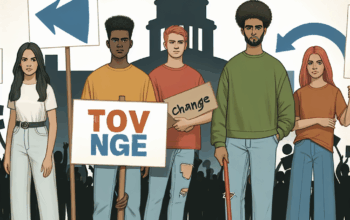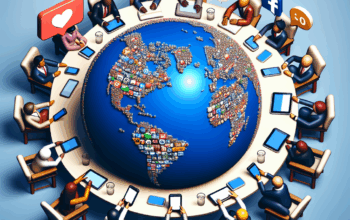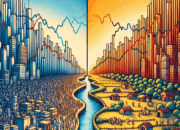Introduction
In recent years, polarization in politics has grown into one of the most prominent challenges faced by democracies worldwide. This phenomenon involves the deepening ideological divide among individuals, political parties, and social groups, culminating in an increasingly adversarial political landscape. The causes of this polarization are multifaceted, encompassing social, economic, technological, and psychological factors. Understanding the consequences of political polarization is equally critical, as it can severely impact governance, social cohesion, and democratic processes. In this article, we will explore the causes and consequences of polarization in politics, particularly in the context of 2025, offering insights and implications for the future.
Understanding Political Polarization
Political polarization refers to the widening ideological gap between opposing political factions, leading to a situation where moderate viewpoints become eclipsed. This ideological extremism often manifests through a commitment to partisanship, resulting in groups aligning rigidly against one another. One central cause of this phenomenon is the role of social media and technology, which have revolutionized communication but also contributed to the formation of echo chambers. In these digital spaces, individuals are often exposed only to viewpoints that reinforce their beliefs, creating a cycle that intensifies ideological divides.
Moreover, the cultural aspect of polarization cannot be overlooked. Factors such as identity politics and cultural narratives significantly shape individual political views. As people increasingly associate their identities with political affiliations—whether related to race, gender, or religion—debate and discussion can turn heated. This cultural entrenchment makes compromise and dialogue more challenging, further perpetuating the cycle of polarization in politics. Engaging with diverse perspectives is becoming rarer, leading to a more fragmented public discourse.
Key Causes of Political Polarization
The causes of polarization in politics are deeply rooted in several interconnected trends and phenomena. First, demographic shifts have played a pivotal role in fostering polarization. The rise of the millennial and Gen Z generations, who hold progressively liberal views on social issues, contrasts sharply with older generations, reinforcing a divide that extends across various societal dimensions. As younger voters increasingly prioritize environmental policies and social justice, longstanding political parties are forced to adapt or risk losing relevance.
Economic inequality is another major factor contributing to political polarization. The growing gap between the wealthiest individuals and the lower and middle classes has led to frustration and resentment. Many citizens feel left behind by the political establishment, which has led to the rise of populist movements on both the left and the right. This economic disenfranchisement fuels a distrust of traditional political institutions and encourages individuals to embrace more radical positions, thus deepening the divides.
The Role of Media in Political Polarization
The media landscape plays a crucial role in shaping political polarization, particularly through selective coverage and framing of issues. News outlets often cater to specific audiences, emphasizing sensationalism over comprehensive reporting to attract viewers. As such, audiences are more likely to consume information that aligns with their pre-existing beliefs, further entrenching partisan divides. Traditional media biases, coupled with the rise of alternative news platforms, contribute to a fragmented information ecosystem that fosters division rather than understanding.
Moreover, algorithms employed by social media platforms exacerbate polarization by curating content that reinforces users’ viewpoints. These platforms create feedback loops by promoting sensational or emotionally charged content, which tends to garner higher engagement. Consequently, users are less exposed to moderate positions or bipartisan discussions. Research has shown that individuals who engage heavily with social media are more likely to adopt extreme political views, illustrating the significant impact of media consumption on polarization.
Lastly, the interaction between media and political messaging has become increasingly sophisticated. Politicians and political organizations are harnessing media channels not just to convey platforms but to shape narratives around opponents. The use of targeted advertisements and disinformation campaigns has heightened animosity and mistrust among citizens, leading to a political climate where compromise is viewed as weakness rather than a pathway to collaborative governance.
Consequences of Political Polarization
The consequences of political polarization are profound, affecting not only individual relationships but also the functioning of democratic institutions. One of the most significant impacts is legislative gridlock. When political polarization reaches extreme levels, elected officials may prioritize loyalty to party over the needs of constituents, resulting in challenges to passing critical legislation. This impasse can undermine public confidence in government effectiveness and lead to frustration among the electorate.
Another consequence of polarization is the erosion of civil discourse. As political factions become increasingly antagonistic, respectful dialogue diminishes. Individuals are less likely to engage with those holding opposing views, leading to social fragmentation. This trend can foster an environment where conflict and hostility become the norm, undermining the principles of democracy that prioritize debate and consensus-building. Social networks may become polarized, influencing interpersonal relationships and community cohesion.
Furthermore, polarization can pave the way for radicalization. When individuals are consistently exposed to extreme viewpoints, they may become more susceptible to adopting radical ideologies or engaging in political violence. This trend poses a significant threat to national security and social stability. Extremist groups often exploit political polarization to recruit followers, perpetuating cycles of violence and division that can have long-lasting impacts on communities.
Mitigating the Effects of Polarization
Addressing political polarization requires multifaceted strategies aimed at rebuilding social trust and encouraging open dialogue. One effective approach is promoting civic education that emphasizes critical thinking and media literacy. By empowering individuals to critically evaluate sources of information and engage with diverse perspectives, such initiatives can foster a more informed electorate capable of navigating complex political landscapes.
Another important strategy is to encourage political leaders and influencers to model respectful discourse. Elected officials should prioritize bipartisanship and seek opportunities for collaboration across party lines. Initiatives that promote cross-party dialogue can help bridge divides and demonstrate the value of cooperation. Programmatic efforts that facilitate interactions between different political groups can also contribute to restoring social trust.
Finally, community engagement is paramount in mitigating political polarization. Grassroots movements and local initiatives can create platforms for dialogue and understanding among citizens. Community forums that bring together diverse opinions can highlight common ground and shared values, reminding citizens of their interconnectedness beyond political labels. By fostering environments where individuals feel safe to express differing views, societies can take meaningful steps toward reducing the intensity of polarization.
Conclusion
In conclusion, polarization in politics is a complex and multifaceted issue, with deep-rooted causes and significant consequences for societies worldwide. The interplay of demographic shifts, economic inequality, and media influence has contributed to an increasingly polarized landscape, making constructive dialogue and governance difficult. However, there are pathways to mitigate polarization through civic education, respectful discourse from leaders, and community engagement. As we move forward in 2025 and beyond, addressing the challenges posed by political polarization will be crucial to ensuring the health and longevity of democratic institutions.
FAQs
What is political polarization?
Political polarization refers to the growing ideological divide between political factions, leading to extreme partisanship and reduced willingness to engage with opposing viewpoints.
What are the main causes of political polarization?
The primary causes of political polarization include demographic shifts, economic inequality, the role of media and technology, and cultural identity factors that shape political affiliations.
How does media contribute to political polarization?
Media contributes to political polarization through selective reporting, sensationalism, and the reinforcement of pre-existing beliefs via social media algorithms, creating echo chambers for different political ideologies.
What are the consequences of polarization in politics?
Consequences of political polarization include legislative gridlock, erosion of civil discourse, decreased community cohesion, and an increased risk of radicalization among citizens.
How can we reduce political polarization?
Reducing political polarization can be achieved through civic education, fostering respectful dialogue among leaders, and promoting community engagement initiatives that encourage open discussion across diverse viewpoints.












